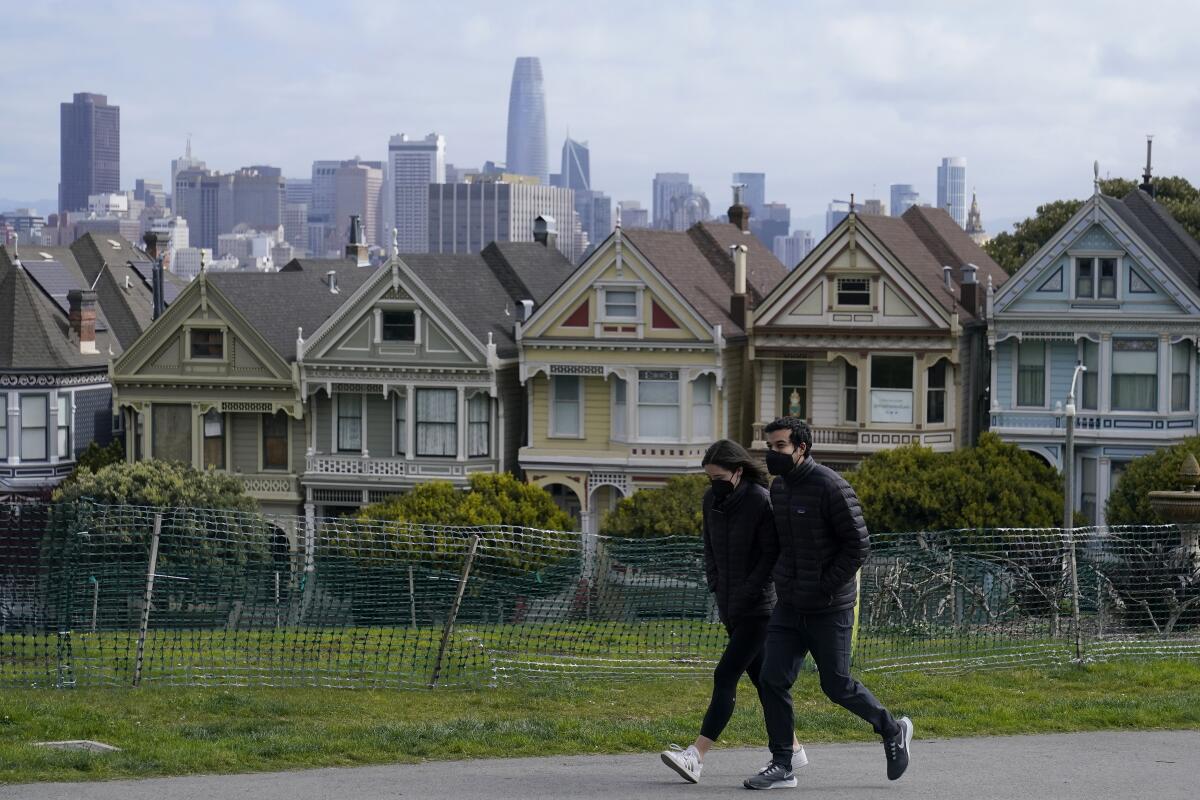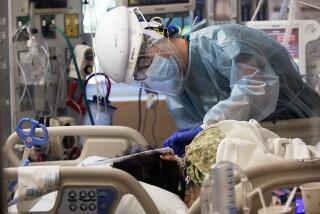Bay Area counties mandate indoor masks, joining L.A. as Delta variant rages

- Share via
SAN FRANCISCO — In another sign the Delta variant is upending California’s attempts to put the COVID-19 pandemic behind it, officials in a large swath of the Bay Area announced Monday that residents will again need to wear masks in indoor public settings regardless of vaccination status.
The move comes several weeks after Los Angeles County became one of the first in the nation to return to an indoor mask mandate, and it greatly expands the number of people in California covered by such rules.
Also on Monday, Kaiser Permanente announced it will make COVID-19 vaccines mandatory for all employees and physicians. The Oakland-based healthcare giant said nearly a quarter of its 240,000 employees remain unvaccinated.
At a news conference Monday, Bay Area health officers stressed that the Delta variant is escalating both cases and hospitalizations, and they predicted deaths also will rise in the coming weeks.
“This is not the same virus we were combating last year,” said Sonoma County Health Officer Dr. Sundari Mase, noting that it is 60% more infectious than previous variants.
The public health order affects Alameda, Contra Costa, Marin, San Francisco, San Mateo, Santa Clara and Sonoma counties and the city of Berkeley.
Most Bay Area residents who have been hospitalized were unvaccinated, but the elderly and people with underlying conditions who were fully inoculated also are succumbing to the Delta variant, the officers said. They said the new mandate arose from a rise in hospitalizations and a new understanding that even the vaccinated may spread the virus, despite the personal protections that vaccines provide.
“Quite frankly,” said Dr. Lisa Hernandez, Berkeley’s health officer, “vaccines are keeping thousands out of Bay Area hospitals and morgues right now.”
The order will go into effect Tuesday, and officials said they intended it to be temporary, although they did not provide a timeline. They also said they hoped requiring masks would preempt the need for more drastic restrictions such as closures of public spaces and businesses.
“The goal of these orders is to avoid disrupting our businesses’ continued operations and residents’ everyday activities,” Dr. Lisa Santora, deputy health officer for Marin County, said at a news conference.
She said the number of breakthrough infections among the fully vaccinated has doubled every month since April.
Restaurants and bars will remain open for indoor service, but patrons will have to wear masks when they are not eating or drinking, the officers said. The officers said they also continue to support the reopening of schools as long as students and staff wear masks.
Dr. Chris Farnitano, Contra Costa’s health officer, said unvaccinated people should avoid indoor dining, gyms and theaters until they are immunized. Four out of 5 people hospitalized for COVID-19 in the county have been unvaccinated, he said.
In Marin County, where vaccination rates are high, about 1 out of every 7 to 8 people hospitalized for COVID-19 were vaccinated.
In Sonoma, 86% of those in the hospital now for COVID-19 are unvaccinated. Two fully vaccinated individuals have died in Sonoma. Both were older than 90 and had underlying health ailments.
In San Francisco, 9.3 out of every 1,000 people are contracting the disease even though they are fully vaccinated. The number for the unvaccinated is 78.2 for every 1,000 people.
Farnitano said most of the COVID-19 patients in Contra Costa hospitals are in their 40s, 50s and early 60s because most older people have been vaccinated. He described the patients as gasping for breath, with tubes down their throats and hooked up to machines.
“Even if you survive a COVID hospitalization, it is a terrible experience,” he said.
San Francisco’s mask mandate came just as the city was celebrating the return of its iconic cable cars, which were shut down in the pandemic.
Dr. Naveena Bobba, San Francisco’s acting health director, stressed that the vaccines continue to be protective. Those who are fully vaccinated remain less likely to contract the disease and more likely to have only mild disease if they do, she said.
On July 17, Los Angeles County started requiring all residents, regardless of vaccination status, to again wear masks in indoor public spaces as case counts ticked upward. Some local governments and business owners are going a step further with more stringent rules such as requiring people to show proof of vaccination before being allowed to enter a place.
While Los Angeles County officials are hoping the mask rules will slow the new surge, it will take at least several more days to know if the measure is effective.
Based on assessment of transmission rates this week, county health officials said in a statement that they “will have a more complete picture to inform this discussion by the end of the week.”
Dr. Neha Nanda, infection control officer for Keck Medicine of USC, said cases are still rising, reflecting a gap between the implementation of the order and its widespread adoption. While it might be too soon to see the precise impact of masking, Nanda was confident it will help rein in the virus.
With the mask mandate, “our numbers will not soar,” said Nanda, who leads the preparation and response to emerging infectious diseases at Keck. “They might still rise,” she added, “but it just may not be so exponential.”
Case rates and hospitalizations so far haven’t matched the devastating levels seen last fall and winter. Preventive measures could help ensure the surge doesn’t turn into another crisis, said Richard Carpiano, professor of public policy and sociology at UC Riverside.
“The idea is that you don’t want to wait until it’s too bad,” he said. “You want to get it kind of ahead of time.”
The current surge in cases is hitting those who are unvaccinated hard. People who are vaccinated are strongly protected against contracting the coronavirus and, if they do contract it, have less serious illnesses.
“The tragic reality is that almost every single person hospitalized and dying from COVID-19 is unvaccinated and these hospitalizations and deaths are, for the most part, preventable,” Barbara Ferrer, the Los Angeles County public health director, said in a statement.
According to data compiled by The Times, 76.7% of San Francisco County residents have received at least one dose of a COVID-19 vaccine and 70.5% are fully vaccinated — well above the 61.5% of Californians who have received at least one dose. Meanwhile, 61.9% of L.A. County residents have received at least one dose of vaccine, and 54.2% are fully vaccinated, according to Times data.
Last week, California urged everyone — even those fully vaccinated — to wear masks indoors while in public, joining a renewed national push to increase protection amid a surge in cases. But the ultimate goal is to persuade those who have not been vaccinated to get their shots, which experts say is vital to reversing the surge.
“As always, as occurred in parts of the Bay Area today, local health jurisdictions may put in place guidance more restrictive than the state based on local conditions,” the California Department of Public Health’s communications office said in a statement.
Nanda, of Keck Medicine, warned that a patchwork of rules could diminish the effectiveness of the reinstated mandates.
People are mobile, and so is the virus. As a result, Nanda expects the effects of the mandates will not be “as impressive” if counties have different requirements.
From July 18 to 24, providers throughout the state administered an average of just more than 64,000 vaccines a day — about 3,100 more daily doses than the week before.
An increasing number of institutions are requiring proof of vaccination in hopes of protecting both workers and the public.
Carpiano said he doesn’t foresee much more guidance coming down from Sacramento.
The politicization of mask mandates and other COVID-19 restrictions could make it a gamble, he said, especially in light of Gov. Gavin Newsom’s upcoming recall election. And he doesn’t see every county falling in line voluntarily. Instead, he envisions the mandates will be “sort of scattershot” throughout the state.
More to Read
Sign up for Essential California
The most important California stories and recommendations in your inbox every morning.
You may occasionally receive promotional content from the Los Angeles Times.












